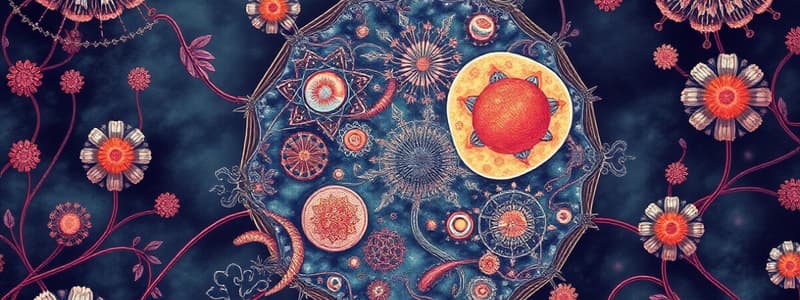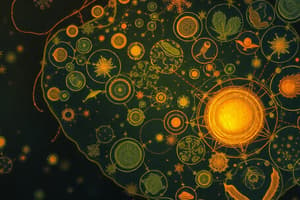Podcast
Questions and Answers
List the seven basic functions integral to the survival of living things.
List the seven basic functions integral to the survival of living things.
Metabolism, Reproduction, Sensitivity, Homeostasis, Excretion, Nutrition, Growth/Movement.
What are the three core principles of the cell theory?
What are the three core principles of the cell theory?
- The cell is the smallest unit of life. 2. All living things are composed of cells (or their cellular products). 3. Cells only arise from pre-existing cells.
What four basic features do all cells share?
What four basic features do all cells share?
They are enclosed by a membrane, contain cytosol, possess genetic material, and have ribosomes.
According to cell theory, spontaneous generation of life is currently possible on Earth.
According to cell theory, spontaneous generation of life is currently possible on Earth.
Striated muscle fibres are considered typical eukaryotic cells.
Striated muscle fibres are considered typical eukaryotic cells.
Why are aseptate fungal hyphae considered atypical eukaryotic cells?
Why are aseptate fungal hyphae considered atypical eukaryotic cells?
What feature makes mature red blood cells atypical eukaryotic cells?
What feature makes mature red blood cells atypical eukaryotic cells?
What does the internal fluid of a cell, where biological processes occur, consist of?
What does the internal fluid of a cell, where biological processes occur, consist of?
Which cellular components function to translate specific genetic instructions?
Which cellular components function to translate specific genetic instructions?
Most cells are measured in _____, while subcellular components may be measured in _____.
Most cells are measured in _____, while subcellular components may be measured in _____.
Which type of microscopy typically views dead specimens in monochrome and uses electromagnets?
Which type of microscopy typically views dead specimens in monochrome and uses electromagnets?
What type of image does a transmission electron microscope (TEM) generate?
What type of image does a transmission electron microscope (TEM) generate?
What type of image does a scanning electron microscope (SEM) render?
What type of image does a scanning electron microscope (SEM) render?
What technique uses antibodies conjugated to fluorescent probes to target specific cellular components for visualization under a light microscope?
What technique uses antibodies conjugated to fluorescent probes to target specific cellular components for visualization under a light microscope?
What microscopy technique involves freezing biological specimens to determine molecular structures at near atomic resolution without crystallization?
What microscopy technique involves freezing biological specimens to determine molecular structures at near atomic resolution without crystallization?
Using the mnemonic MIA, the formula for magnification is: Magnification = _____ _____ ÷ Actual size
Using the mnemonic MIA, the formula for magnification is: Magnification = _____ _____ ÷ Actual size
Using the mnemonic AIM, the formula for actual size is: Actual size = _____ _____ ÷ Magnification
Using the mnemonic AIM, the formula for actual size is: Actual size = _____ _____ ÷ Magnification
Match the unit prefix with its corresponding power of 10.
Match the unit prefix with its corresponding power of 10.
Flashcards
Metabolism
Metabolism
Undertaking essential chemical reactions.
Reproduction
Reproduction
Producing offspring, either sexually or asexually.
Sensitivity
Sensitivity
Being responsive to internal and external stimuli.
Homeostasis
Homeostasis
Signup and view all the flashcards
Excretion
Excretion
Signup and view all the flashcards
Nutrition
Nutrition
Signup and view all the flashcards
Cell Theory
Cell Theory
Signup and view all the flashcards
Cell Membrane
Cell Membrane
Signup and view all the flashcards
Cytosol
Cytosol
Signup and view all the flashcards
Genetic Material
Genetic Material
Signup and view all the flashcards
Ribosomes
Ribosomes
Signup and view all the flashcards
Multinucleated cells
Multinucleated cells
Signup and view all the flashcards
Aseptate fungal hyphae
Aseptate fungal hyphae
Signup and view all the flashcards
Sieve tube elements
Sieve tube elements
Signup and view all the flashcards
Red Blood Cells
Red Blood Cells
Signup and view all the flashcards
Microscope
Microscope
Signup and view all the flashcards
Light Microscopy
Light Microscopy
Signup and view all the flashcards
Electron Microscopy
Electron Microscopy
Signup and view all the flashcards
Micrometer
Micrometer
Signup and view all the flashcards
Nanometer
Nanometer
Signup and view all the flashcards
Study Notes
- Cell theory describes the structural organization of all living things.
Functions of Life
- Metabolism: Living things undertake essential chemical reactions
- Reproduction: Living things produce offspring, either sexually or asexually
- Sensitivity: Living things respond to internal and external stimuli.
- Homeostasis: Living things maintain a stable internal environment.
- Excretion: Living things remove waste products.
- Nutrition: Living things exchange materials and gases with the environment
- Growth / Movement: Living things can move, and change shape or size
Cell Theory Principles
- The cell is the smallest unit of life; unicellular organisms carry out all seven life functions
- All living things consist of cells or their cellular products like hair and nails
- Cells arise only from pre-existing cells, disproving spontaneous generation
Cell Features
- Cells have a surrounding membrane that separates internal contents from the external environment
- Cells contain cytosol, an internal fluid where biological processes occur
- Cells contain genetic material, which is a blueprint for cellular activity
- Cells contain ribosomes which translate the specific genetic instructions within the cell.
Atypical Cells
- Striated muscle fibres are multinucleated because they form from fused individual muscle cells
- Aseptate fungal hyphae lack internal partitions and have continuous cytoplasm
- Sieve tube elements connect via plasmodesmata, supracellular assemblies along plant stems
- Red blood cells lack a nucleus and cannot replicate, new cells are produced by bone marrow
Cell Size
- Cells and their components are measured in micrometres (10⁻⁶ meters) or nanometres (10⁻⁹ meters)
- Metric system prefixes for measurement from largest to smallest unit are: metre (m), centimetre (cm), millimetre (mm), micrometre (µm), and nanometre (nm)
Microscopes
- Microscopes are used to view cells as most cells are too small to view with the naked eye.
Light Microscopy
- Light microscopy views living specimens in natural colour, using lenses to bend light
- Light microscopy has lower resolution and magnification (~100x)
Electron Microscopy
- Electron microscopy views dead specimens in monochrome using electromagnets
- Electron microscopy has higher resolution and magnification
- Transmission electron microscopes generate a cross-section
- Scanning electron microscopes render a 3D surface map
Microscope Developments
- Immunofluorescence: Uses antibodies conjugated to fluorescent probes to target cell components
- The fluorescent probe can be conjugated directly or indirectly via a secondary antibody, visualized under a light microscope with filters
- Cryogenic electron microscopy: Freezing biological specimens for electron microscope visualization
- Allows molecular structure determination at near-atomic resolution by freeze fracturing
Magnification Calculations
- Magnification (MIA): Magnification = Image size ÷ Actual size
- Actual Size (AIM): Actual size = Image size ÷ Magnification
- All sizes must be in the same units for calculations
Studying That Suits You
Use AI to generate personalized quizzes and flashcards to suit your learning preferences.




